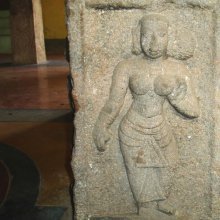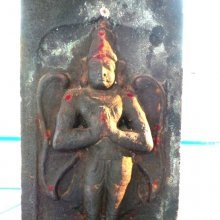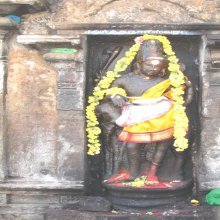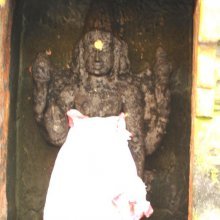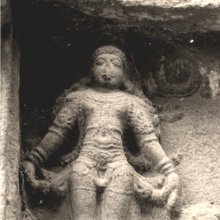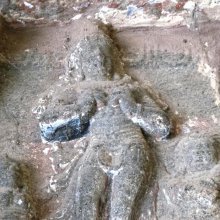Samapada, Sama-pada, Samapādā, Samapāda: 12 definitions
Introduction:
Samapada means something in Hinduism, Sanskrit. If you want to know the exact meaning, history, etymology or English translation of this term then check out the descriptions on this page. Add your comment or reference to a book if you want to contribute to this summary article.
Images (photo gallery)
(+2 more images available)
In Hinduism
Shilpashastra (iconography)
Source: Google Books: The Theory of Citrasutras in Indian PaintingSamapāda (समपाद).—The Samarāṅgaṇa-sūtradhāra (80.5b-6a) states that Brahmā is the tutelary deity of samapāda (“even feet”). In this position the distance between the feet is of 1 tāla. The samapāda posture is also mentioned in the Viṣṇudharmottara-purāṇa (3.39.45) as having straight legs. The Nāṭya-śāstra (11.58-60) explains that this position should be employed for the people receiving blessings from Brahmans, the brideroom wearing the auspicious thread, persons moving in the sky, persons in a chariot or aerial cars, Śaiva devotees and persons obeserving vows.
Source: Shodhganga: The significance of the mūla-beras (śilpa)Samapāda (समपाद) or Samapādasthānaka refers to the “erect posture”, and represents one of the two types of Sthānaka (standing poses), according to Ganapati Sthapati in his text Ciṟpa Cennūl, as defined according to texts dealing with śilpa (arts and crafs), known as śilpaśāstras.—In the samapāda-sthānaka, the head and body are held erect with legs and arms close together. There is no flexion in the body. The gaze is direct. Candraśekhara and Viṣṇu are good examples of this posture. Samapāda-sthānaka is of two types, namely vaitastika-sthānaka and ardhavaitastika-sthānaka.
In iconography the samapāda-sthānaka is again sub-divided into vaitastika-sthānaka (the distance between the big toes is equal to one vitasti, that is, two cāṇ or the span of the thumb to the little finger) and ardhavaitastika-sthānaka (the distance is half vitasti or one cāṇ). The deities found in this sthānaka are Candraśekhara Mūrti and Viṣṇu.

Shilpashastra (शिल्पशास्त्र, śilpaśāstra) represents the ancient Indian science (shastra) of creative arts (shilpa) such as sculpture, iconography and painting. Closely related to Vastushastra (architecture), they often share the same literature.
Natyashastra (theatrics and dramaturgy)
Source: Wisdom Library: Nāṭya-śāstraSamapādā (समपादा) refers to a one of the thirty-two cārīs, according to the Nāṭyaśāstra chapter 11. The Samapādā-cārī is classified as a bhaumī, or “earthly”, of which there are sixteen in total. The term cārī refers to a “dance-step” and refers to the simultaneous movement of the feet (pāda), shanks (jaṅghā) and the hip (ūru). From these cārīs proceed dance as well as movements in general.
Source: archive.org: Natya Shastra1) Samapādā (समपादा).—A type of earthly (bhaumī) dance-step (cārī);—Instructions: the two feet close together, the nails [of the toes] meeting, and standing on the spot.
2) Samapāda (समपाद).—A type of standing-posture (sthāna);—Instructions: the feet in the natural posture and kept one Tāla apart, and the body with the natural Sauṣṭhava. Brahmā is its presiding deity.
(Uses): It should be assumed in accepting blessings from the Brahmins, and in mimicking birds. The bridegroom at the marriage ceremony, persons in the sky, chariot and aerial car (vimāna), person of marked sects (liṅgasthā) and persons practising vows are also to assume this.
Source: Shodhganga: The significance of the mūla-beras (natya)Samapāda (समपाद) is one of the six divisions of sthānaka, one of the nine maṇḍala (postures of the feet) which in turn represents one of the four “movements of the feet” (pāda) according to the Abhinayadarpaṇa. The samapāda-sthānaka, a division of the sthānaka-maṇḍala, is an erect posture, with the feet equidistant from the madhya-sūtra. The body is without any flexion in any direction. The definition for the samapāda-sthānaka is the same in the two arts.
Source: Shodhganga: Elements of Art and Architecture in the Trtiyakhanda of the Visnudharmottarapurana (natya)Samapāda (समपाद) refers to “one of the six kinds of standing postures for Men” (in Indian Dramas), according to the Viṣṇudharmottarapurāṇa, an ancient Sanskrit text which (being encyclopedic in nature) deals with a variety of cultural topics such as arts, architecture, music, grammar and astronomy.—Standing postures are determined separately for male and female. In the Viṣṇudharmottarapurāṇa six kinds of standing postures are discussed for men. The word sama denotes the equal position. In samapāda position, both the legs are placed at a distance of one tāla. This posture is seen in the auspicious performance of Brahmins. This posture is also used to denote jumping of birds and sitting in chariot or aeroplanes.

Natyashastra (नाट्यशास्त्र, nāṭyaśāstra) refers to both the ancient Indian tradition (shastra) of performing arts, (natya—theatrics, drama, dance, music), as well as the name of a Sanskrit work dealing with these subjects. It also teaches the rules for composing Dramatic plays (nataka), construction and performance of Theater, and Poetic works (kavya).
Languages of India and abroad
Sanskrit dictionary
Source: DDSA: The practical Sanskrit-English dictionarySamapada (समपद).—
1) an attitude in shooting.
2) a particular posture in sexual union.
Derivable forms: samapadam (समपदम्).
Samapada is a Sanskrit compound consisting of the terms sama and pada (पद).
Source: Cologne Digital Sanskrit Dictionaries: Shabda-Sagara Sanskrit-English DictionarySamapāda (समपाद).—n.
(-daṃ) An attitude in shooting, standing with the feet even. E. sama even, pāda the foot; also read samapada .
Source: Cologne Digital Sanskrit Dictionaries: Monier-Williams Sanskrit-English Dictionary1) Samapada (समपद):—[=sama-pada] [from sama] m. ‘holding the feet even’, a [particular] posture in sexual union, [cf. Lexicographers, esp. such as amarasiṃha, halāyudha, hemacandra, etc.]
2) [v.s. ...] an attitude in shooting, [ib.]
3) Samapāda (समपाद):—[=sama-pāda] [from sama] n. ‘holding the feet even’, a [particular] posture in dancing, [Saṃgīta-sārasaṃgraha]
4) [v.s. ...] a posture in shooting, [cf. Lexicographers, esp. such as amarasiṃha, halāyudha, hemacandra, etc.]
Source: Cologne Digital Sanskrit Dictionaries: Yates Sanskrit-English DictionarySamapāda (समपाद):—[sama-pāda] (daṃ) 1. n. Shooting attitude.
[Sanskrit to German]
Sanskrit, also spelled संस्कृतम् (saṃskṛtam), is an ancient language of India commonly seen as the grandmother of the Indo-European language family (even English!). Closely allied with Prakrit and Pali, Sanskrit is more exhaustive in both grammar and terms and has the most extensive collection of literature in the world, greatly surpassing its sister-languages Greek and Latin.
Kannada-English dictionary
Source: Alar: Kannada-English corpusSamapāda (ಸಮಪಾದ):—
1) [noun] a standing position in which both the feet are kept together on the same plane.
2) [noun] a particular standing position in sword-fight, mace-fight, etc.
3) [noun] the fact of all the lines in a verse being equal in the prosodic length.
4) [noun] (dance.) a standing in a natural position, keeping a gap of one span (approx. nine inches) between the feet.
Kannada is a Dravidian language (as opposed to the Indo-European language family) mainly spoken in the southwestern region of India.
See also (Relevant definitions)
Partial matches: Pada, Cama, Sama, Pata.
Starts with: Cama-pataviruttam, Samapadacari, Samapadana, Samapadaniya, Samapadasthanaka, Samapadati.
Query error!
Full-text (+48): Samapadasthanaka, Sthanaka, Samapadacari, Vicyava, Dhanvisthana, Pattabhirama, Cama-pataviruttam, Parthasarathi, Sitting, Jumping, Karuppana, Auspicious performance, Lakshmana, Antal, Lingastha, Shrinivasa-sundaraja, Rama, Candrashekhara, Kiratamurti, Candrashekar.
Relevant text
Search found 19 books and stories containing Samapada, Sama-pada, Sama-pāda, Samapādā, Samapāda; (plurals include: Samapadas, padas, pādas, Samapādās, Samapādas). You can also click to the full overview containing English textual excerpts. Below are direct links for the most relevant articles:
Gati in Theory and Practice (by Dr. Sujatha Mohan)
Gati in vehicles < [Chapter 3 - Application of gati in Dṛśya-kāvyas]
Gaits pertaining to conditions < [Chapter 2 - Concept and technique of Gati]
Performance of Cārī < [Chapter 2 - Concept and technique of Gati]
Amarakoshodghatana of Kshirasvamin (study) (by A. Yamuna Devi)
Education (10): Knowledge in Archery < [Chapter 4 - Cultural Aspects]
Vishnudharmottara Purana (Art and Architecture) (by Bhagyashree Sarma)
2.3. Standing Postures < [Chapter 3 - Drama and Dance]
2. The Viṣṇudharmottara-purāṇa and the Indian Classical Dances < [Chapter 6 - Modern Relevance of Different Art Forms and Architecture]
Natyashastra (English) (by Bharata-muni)
Part 7 - Data of India’s Cultural History in the Nāṭyaśāstra < [Introduction, part 1]
Prayogamanjari and Saivagamanibandhana (Study) (by R. Suthashi)
Description of Candrasekhara-Murti < [Chapter 4 - Anthropomorphic forms of Shiva in Kerala Tantric works]
Notices of Sanskrit Manuscripts (by Rajendralala Mitra)
Page 280 < [Volume 7 (1883)]
